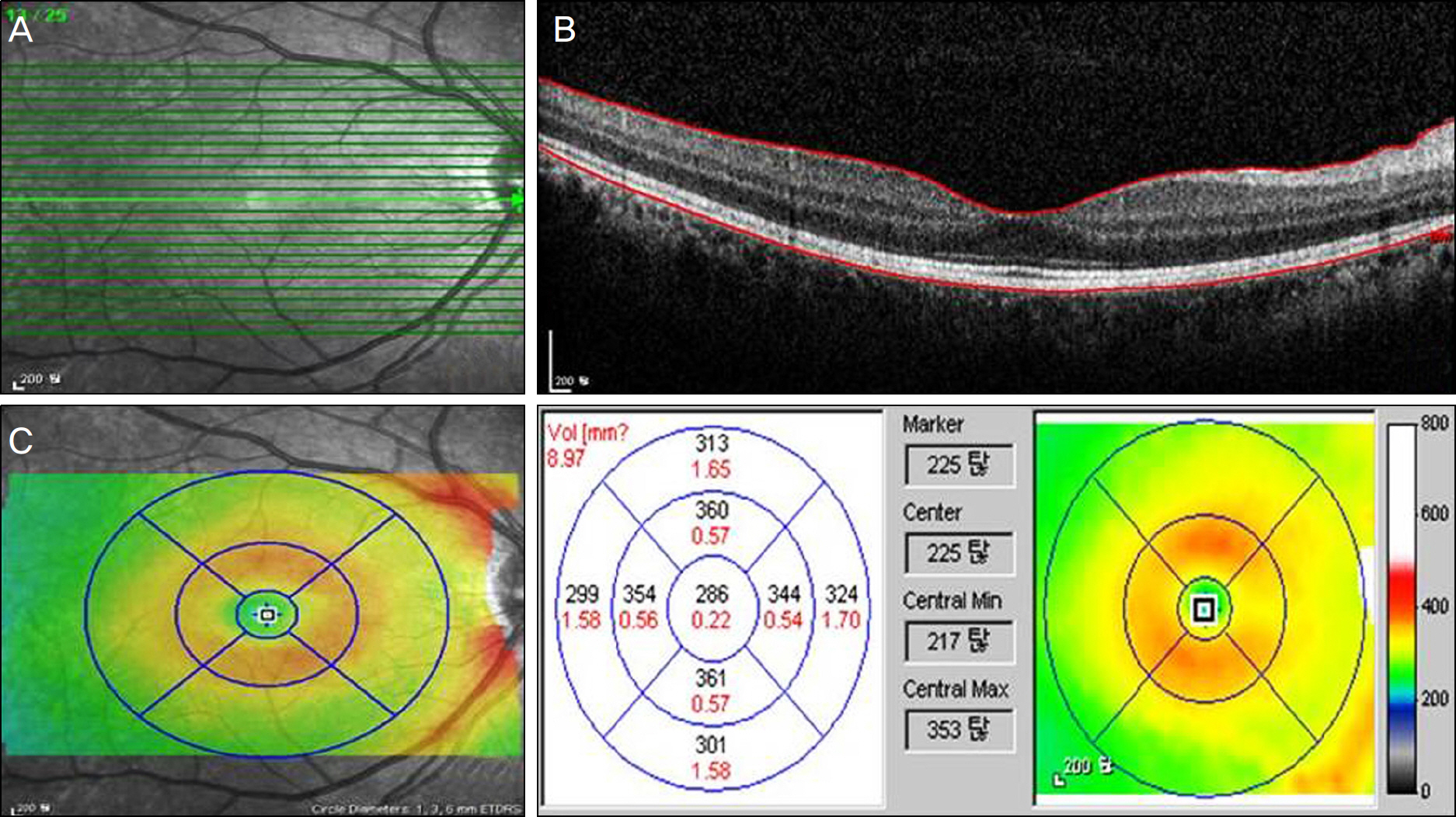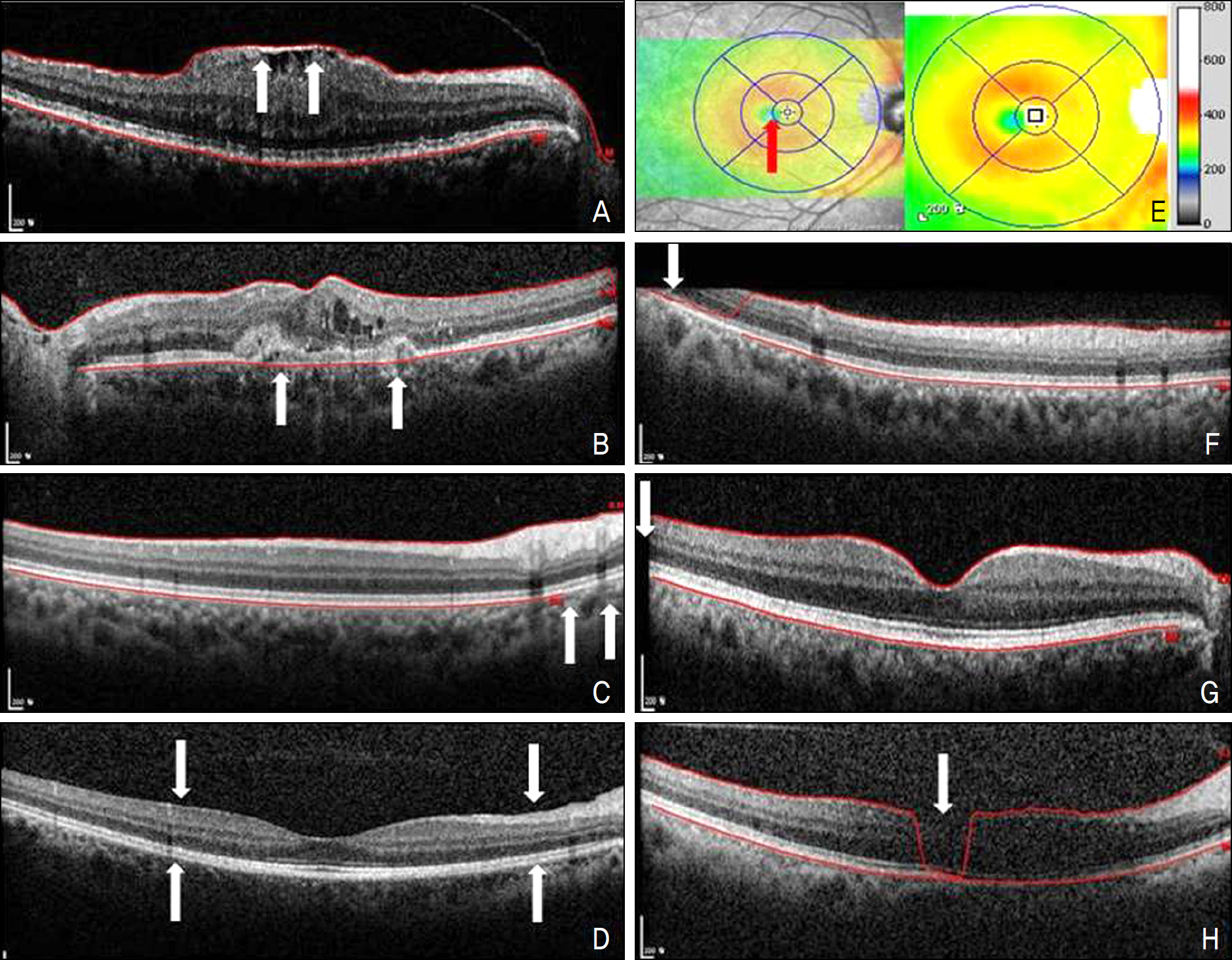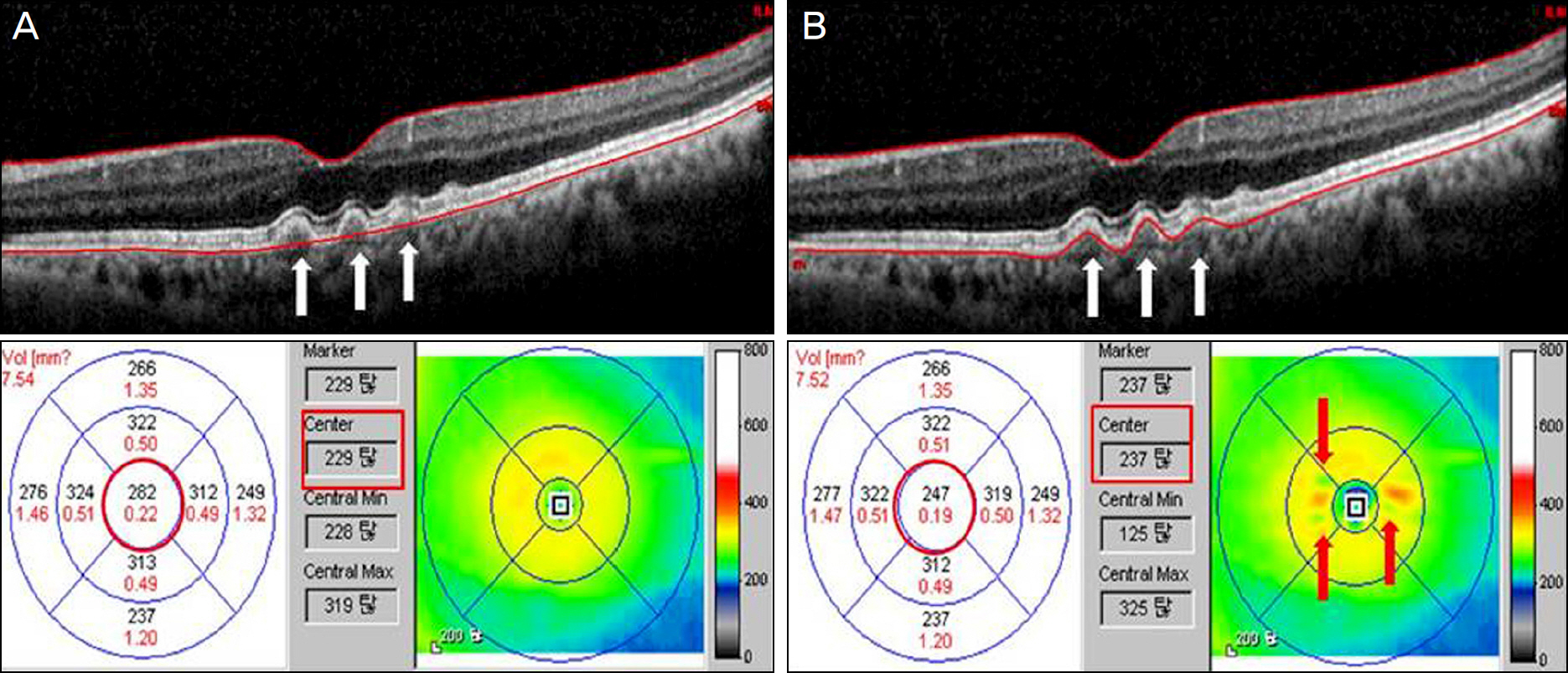J Korean Ophthalmol Soc.
2011 Aug;52(8):943-951. 10.3341/jkos.2011.52.8.943.
Artifacts Associated with Spectral-Domain Optical Coherence Tomography
- Affiliations
-
- 1Department of Ophthalmology, Konkuk University Medical Center, Konkuk University School of Medicine, Seoul, Korea. eyekim@kuh.ac.kr
- KMID: 2214771
- DOI: http://doi.org/10.3341/jkos.2011.52.8.943
Abstract
- PURPOSE
To report frequencies of image artifacts associated with spectral-domain optical coherence tomography (SD-OCT) and to evaluate the impact of artifacts on foveal thickness measurements.
METHODS
This retrospective study included 267 eyes of 267 patients who underwent OCT volume scanning using Spectralis HRA+OCT (Heidelberg Engineering, Heidelberg, Germany). Macular volume scans of normal and diseased eyes were systematically evaluated for image artifacts within each scan overall and within the center 1-mm area. The frequency of each artifact type was compared for scans stratified by diagnosis category.
RESULTS
Among the volume scans, 79.4% had at least 1 artifact overall, and 26.6% had at least 1 artifact in the center 1-mm area. The highest percentage of inner retina misidentification occurred in the epiretinal membrane (36.1%), whereas the highest percentage of outer retina misidentification occurred in neovascular age-related macular degeneration (wet AMD, 40.0%). Clinically significant artifacts involving the center 1-mm area were observed in 6.4% of volume scans and were most common in wet AMD (43.3%).
CONCLUSIONS
Image artifacts in SD-OCT volume scanning are common, but relatively less common in the center 1-mm area of scans. Clinicians should carefully review scans for artifacts when using SD-OCT images and retinal thickness measurements because clinically significant artifacts may affect retinal thickness measurements.
MeSH Terms
Figure
Cited by 1 articles
-
Changes in the Ganglion Cell-inner Plexiform Layer after Consecutive Intravitreal Injections of Anti-vascular Endothelial Growth Factor in Age-related Macular Degeneration Patients
Se Young Kim, Myung Hun Yoon, Hee Seung Chin
Korean J Ophthalmol. 2020;34(1):11-18. doi: 10.3341/kjo.2019.0081.
Reference
-
References
1. Leung CK, Chan WM, Chong KK, et al. Alignment artifacts in optical coherence tomography analyzed images. Ophthalmology. 2007; 114:263–70.
Article2. Patel PJ, Chen FK, da Cruz L, Tufail A. Segmentation error in Stratus optical coherence tomography for neovascular age-related macular degeneration. Invest Ophthalmol Vis Sci. 2009; 50:399–404.
Article3. Ghazi NG, Kirk T, Allam S, Yan G. Quantification of error in optical coherence tomography central macular thickness measurement in wet age-related macular degeneration. Am J Ophthalmol. 2009; 148:90–6.
Article4. Ray R, Stinnett SS, Jaffe GJ. Evaluation of image artifact produced by optical coherence tomography of retinal pathology. Am J Ophthalmol. 2005; 139:18–29.
Article5. Sadda SR, Wu Z, Walsh AC, et al. Errors in retinal thickness measurements obtained by optical coherence tomography. Ophthalmology. 2006; 113:285–93.
Article6. Sadda SR, Joeres S, Wu Z, et al. Error correction and quantitative subanalysis of optical coherence tomography data using aberrations grading. Invest Ophthalmol Vis Sci. 2007; 48:839–48.7. Domalpally A, Danis RP, Zhang B, et al. Quality issues in interpretation of optical coherence tomograms in macular diseases. Retina. 2009; 29:775–81.
Article8. Hangai M, Ojima Y, Gotoh N, et al. Three-dimensional imaging of macular holes with high-speed optical coherence tomography. Ophthalmology. 2007; 114:763–73.
Article9. Ahlers C, Michels S, Beckendorf A, et al. Three-dimensional imaging of pigment epithelial detachment in age-related macular degeneration using optical coherence tomography, retinal thickness analysis and topographic angiography. Graefes Arch Clin Exp Ophthalmol. 2006; 244:1233–9.
Article10. Ho J, Sull AC, Vuong LN, et al. Assessment of artifacts and reproducibility across spectral- and time-domain optical coherence tomography devices. Ophthalmology. 2009; 116:1960–70.
Article11. Han IC, Jaffe GJ. Evaluation of artifacts associated with macular spectral-domain optical coherence tomography. Ophthalmology. 2010; 117:1177–89.
Article12. Tappeiner C, Barthelmes D, Abegg MH, et al. Impact of optic media opacities and image compression on quantitative analysis of optical coherence tomography. Invest Ophthalmol Vis Sci. 2008; 49:1609–14.
Article13. Kok PH, van Dijk HW, van den Berg TJ, Verbraak FD. A model for the effect of disturbances in the optical media on the OCT image quality. Invest Ophthalmol Vis Sci. 2009; 50:787–92.
Article14. Diabetic Retinopathy Clinical Research Network. Reproducibility of macular thickness and volume using Zeiss optical coherence tomography in patients with diabetic macular edema. Ophthalmology. 2007; 114:1520–5.15. Browning DJ, Fraser CM, Propst BW. The variation in optical coherence tomography-measured macular thickness in diabetic eyes without clinical macular edema. Am J Ophthalmol. 2008; 145:889–93.
Article16. Forooghian F, Cukras C, Meyerle CB, et al. Evaluation of time domain and spectral domain optical coherence tomography in the measurement of diabetic macular edema. Invest Ophthalmol Vis Sci. 2008; 49:4290–6.
Article17. Wolf-Schnurrbusch UE, Ceklic L, Brinkmann CK, et al. Macular thickness measurements in healthy eyes using six different optical coherence tomography instruments. Invest Ophthalmol Vis Sci. 2009; 50:3432–7.
Article18. Leung CK, Cheung CY, Weinreb RN, et al. Comparison of macular thickness measurements between time domain and spectral domain optical coherence tomography. Invest Ophthalmol Vis Sci. 2008; 49:4893–7.
Article19. Patel PJ, Chen FK, Ikeji F, et al. Repeatability of stratus optical coherence tomography measures in neovascular age-related macular degeneration. Invest Ophthalmol Vis Sci. 2008; 49:1084–8.
Article
- Full Text Links
- Actions
-
Cited
- CITED
-
- Close
- Share
- Similar articles
-
- Analysis of Various Artifacts Produced by Spectral-Domain Optical Coherence Tomography Based on Macular Pathologies
- A Case of Ocular Toxoplasmosis Imaged with Spectral Domain Optical Coherence Tomography
- Fundus Autofluorescence, Fluorescein Angiography and Spectral Domain Optical Coherence Tomography Findings of Retinal Astrocytic Hamartomas in Tuberous Sclerosis
- A Case of Double Fovea Artifact Detected with Spectral-domain Optical Coherence Tomography
- Comparison of the Efficacy between Time and Spectral Domain Optical Coherence Tomography for the Identification of Vitreomacular Interface




